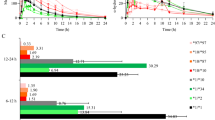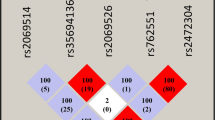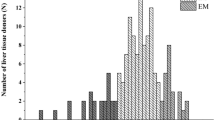Abstract
Candesartan cilexetil is an angiotensin II receptor antagonist, and candesartan, its active metabolite, is metabolized by CYP2C9. However, the effect of CYP2C9*3 on candesartan metabolism is not established. We characterized the kinetics of candesartan by CYP2C9*1/*1 and CYP2C9*1/*3 in human liver microsomes. The difference between the two was not significant. Subsequently, CYP2C9*1 and CYP2C9*3 (Leu359) were expressed in yeast, and the kinetics of candesartan were determined. The wild-type showed the lower Km (345 vs 439 μM; 3/4) and higher Vmax/Km (1/3) than the Leu359 variant. Also, we investigated potential interaction between candesartan and warfarin with both the wild-type and the Leu359 variant. Candesartan had no effect on S-warfarin 7-hydroxylation. In contrast, S-warfarin inhibited candesartan metabolism by the wild-type (Ki = 17 μM) greater than by the Leu359 variant (Ki = 36 μM). These findings suggest that CYP2C9*3 may change not only the metabolic activity but also the inhibitory susceptibility compared with CYP2C9*1.
This is a preview of subscription content, access via your institution
Access options
Subscribe to this journal
Receive 6 print issues and online access
$259.00 per year
only $43.17 per issue
Buy this article
- Purchase on Springer Link
- Instant access to full article PDF
Prices may be subject to local taxes which are calculated during checkout



Similar content being viewed by others
References
Shibouta Y, Inada Y, Ojima M, Wada T, Noda M, Sanada T et al. Pharmacological profile of a highly potent and long-acting angiotensin II receptor antagonist, 2-ethoxy-1-[[2′-(1H-ttrazol-5-yl)biphenyl-4-yl]methyl]-1H-benzimidazole-7-carboxylic acid (CV-11874), and its prodrug, (±)-1-(cyclohexyloxycarbonyloxy)-ethyl 2-ethoxy-1-[[2′-(1H-tetrazol-5-yl)biphenyl-4-yl]methyl]-1H-benzimidazole-7-carboxylate (TCV-116) J Pharm Exp Ther 1993 266: 114–120
McClellan KJ, Goa KL . Candesartan cilexetil Drugs 1998 56: 847–869
Miners JO, Birkett DJ . Cytochrome P4502C9: an enzyme of major importance in human metabolism Br J Clin Pharmacol 1998 45: 525–538
Wang Sl, Huang J, Lai MD, Tsai JJ . Detection of CYP2C9 polymorphism based on the polymerase chain reaction in Chinese Pharmacogenetics 1995 5: 37–42
Nasu K, Kubota T, Ishizaki T . Genetic analysis of CYP2C9 polymorphism in a Japanese population Pharmacogenetics 1997 7: 405–449
Steward DJ, Haining RL, Henne KR, Davis G, Rushmore TH, Trager WF et al. Genetic association between sensitivity to warfarin and expression of CYP2C9*3 Pharmacogenetics 1997 7: 361–367
Sullivan-Klose TH, Ghanayem BI, Bell DA, Zhang ZY, Kaminsky LS, Shenfield GM et al. The role of the CYP2C9-Leu359 allelic variant in the tolbutamide polymorphism Pharmacogenetics 1996 6: 341–349
Odani A, Hashimoto Y, Otsuki Y, Uwai Y, Hattori H, Furusho K et al. Genetic polymorphism of the CYP2C subfamily and its effect on the pharmacokinetics of phenytoin in Japanese patients with epilepsy Clin Pharmacol Ther 1997 62: 287–292
Haining RL, Hunter AP, Veronese ME, Trager WF, Rettie AE . Allelic variants of human cytochrome P450 2C9: baculovirus-mediated expression, purification, structural characterization, substrate stereoselectivity, and prochiral selectivity of the wild-type and I359L mutant form Arch Biochem Biophys 1996 333: 447–458
John OM, Sally C, Donald JB, Joyce AG . Torsemide metabolism by CYP2C9 variants and other human CYP2C subfamily enzymes Pharmacogenetics 2000 10: 267–270
Kidd RS, Straughn AB, Meyer MC, Blaisdell J, Goldstein JA, Dalton JT . Pharmacokinetics of chlorpheniramine, phenytoin, glipizide and nifedipine in an individual homozygous for the CYP2C9*3 allele Pharmacogenetics 1999 9: 71–80
Yamazaki H, Inoue K, Chiba K, Ozaa N, Kawai T, Suzuki Y et al. Comparative studies on the catalytic roles of cytohrome P450 2C9 and its Cys- and Leu-variants in the oxidation of warfarin, flurbiprofen, and diclofenac by human liver microsomes Biochem Pharmacol 1998 56: 243–253
Bourrie M, Meunier V, Berger Y, Fabre G . Role of cytochrome P-4502C9 in irbesartan oxidation by human liver microsomes Drug Metab Dispos 1999 27: 288–296
Tang C, Shou M, Mei Q, Rushmore TH, Rodrigues AD . Major role of human liver microsomal cytochrome P450 2C9 (CYP2C9) in the oxidative metabolism of celecoxib, a novel cyclooxygenase-II inhibitor J Pharmacol Exp Ther 2000 293: 453–459
Hemeryck A, De Vriendt C, Belpaire FM . Inhibition of CYP2C9 by selective serotonin reuptake inhibitors: in vitro studies with tolbutamide and (S)-warfarin using human liver microsomes Eur J Clin Pharmacol 1999 54: 947–951
Takanashi K, Tainaka H, Kobayashi K, Yasumori T, Hosakawa M, Chiba K . CYP2C9 Ile359 and Leu359 variants: enzyme kinetic study with seven substrates Pharmacogenetics 2000 10: 95–104
Taavitssainen P, Kiukaanniemi K, Pelkonen O . In vitro inhibition screening of human hepatic P450 enzymes by five angiotensin-II receptor antagonists Eur J Clin Pharmacol 2000 56: 135–140
Takahashi H, Kashima T, Nomoto S, Iwade K, Tainaka H, Shimizu T, et al. Comparisons between in-vitro and in-vivo metabolism of (S)-warfarin: catalytic activities of cDNA–expressed CYP2C9, its Leu359 variant and their mixture versus unbound clearance in patients with the the corresponding CYP2C9 genotypes Pharmacogenetics 1998 8: 365–373
Sakaki T, Akiyoshi S . M, Yabusaki Y, Ohkawa H. Organella-targeted expression of rat liver cytochrome P450c27 in yeast J Biol Chem 1992 267: 16497–16502
Wan J, Imaoka S, Chow T, Hiroi T, Yabusaki Y, Funae Y . Expression of four rat CYP2D isoforms in Saccharomyces cerevisiae and their catalytic specificity Arch Biochem Biophys 1997 348: 383–390
Murakami H, Yabusaki Y, Ohkawa H . Expression of rat NADPH-cytochrome P-450 reductase cDNA in Saccharomyces cerevisiae DNA 1986 5: 1–10
Miyabayashi T, Okuda T, Motohashi M, Izawa K, Yashiki T . Quantitation of a new potent angiotensin II receptor antagonist, TCV-116, and its metabolites in human serum and urine J Chromatogr B 1996 677: 123–132
Author information
Authors and Affiliations
Corresponding author
Rights and permissions
About this article
Cite this article
Hanatani, T., Fukuda, T., Ikeda, M. et al. CYP2C9*3 influences the metabolism and the drug-interaction of candesartan in vitro. Pharmacogenomics J 1, 288–292 (2001). https://doi.org/10.1038/sj.tpj.6500063
Received:
Revised:
Accepted:
Published:
Issue Date:
DOI: https://doi.org/10.1038/sj.tpj.6500063
Keywords
This article is cited by
-
Physiologically based pharmacokinetic modeling of candesartan related to CYP2C9 genetic polymorphism in adult and pediatric patients
Archives of Pharmacal Research (2021)
-
Functional characterization of 32 CYP2C9 allelic variants
The Pharmacogenomics Journal (2014)
-
Predictors of Blood Pressure Response to the Angiotensin Receptor Blocker Candesartan in Essential Hypertension
American Journal of Hypertension (2008)



